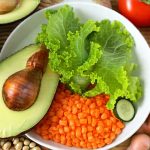Indigestion is a remarkably common experience, impacting countless individuals worldwide. It’s rarely a serious condition in itself, but its unpleasant symptoms – bloating, heartburn, gas, nausea, and stomach discomfort – can significantly disrupt daily life. While often attributed to overeating or specific food intolerances, the combinations of foods we consume frequently play a crucial role in digestive wellbeing. Many traditional healing systems, like Ayurveda, have long recognized this principle, emphasizing that how we combine foods is just as important as what we eat. Understanding these principles isn’t about restrictive dieting; it’s about fostering a more harmonious relationship with your body and optimizing your digestive processes for greater comfort and vitality.
Modern dietary advice often focuses on macronutrient ratios or calorie counting, sometimes overlooking the fundamental way our bodies actually process food. Digestion is a complex multi-stage process requiring different enzymes, acids, and transit times for various food groups. When we haphazardly combine foods that demand conflicting digestive efforts, it can overwhelm the system, leading to incomplete breakdown of nutrients and the unpleasant symptoms associated with indigestion. This article will explore the core principles behind food combining, offering practical guidance on how to minimize digestive discomfort by making mindful choices about what you eat together. If you suspect food intolerances are contributing, consider exploring how doctors confirm gut damage through medical testing.
The Core Principles of Food Combining
Food combining isn’t a rigid set of rules but rather a guiding philosophy based on understanding how different foods are digested. At its heart is the idea that certain combinations place undue stress on the digestive system, while others promote efficient breakdown and absorption. A key concept revolves around digestive timing – the speed at which various food groups transit through the digestive tract. For example, fruits generally digest quickly, whereas proteins and fats take much longer. Combining a rapidly digestible fruit with a slow-digesting protein can lead to fermentation of the fruit in the stomach while the protein is still being processed, resulting in gas, bloating, and discomfort. Paying attention to how to time meals can also significantly reduce these effects.
Another important principle concerns enzyme requirements. Different food groups require different enzymes for optimal digestion. For instance, carbohydrate digestion relies heavily on amylase, while protein digestion necessitates protease. When foods requiring conflicting enzymes are consumed simultaneously, the digestive system must work harder – potentially leading to incomplete breakdown and malabsorption. This can also contribute to feelings of sluggishness after meals. The aim isn’t necessarily to eliminate all “problem” combinations, but rather to be aware of them and minimize their frequency, especially if you’re prone to indigestion. You might even consider food combining principles to help reduce gas production.
Ultimately, the goal is to support your body’s natural digestive processes by making informed choices that reduce strain on the system. This involves paying attention to how you feel after eating certain combinations – everyone’s digestive sensitivity varies. What works well for one person might not work as effectively for another. Experimentation and mindful observation are key to discovering what supports your individual wellbeing.
Common Problematic Food Combinations
Several food pairings are frequently cited as potentially problematic in the context of food combining, although it’s crucial to remember that these aren’t universally applicable rules. However, understanding why they might cause issues can inform more conscious eating habits. One classic example is pairing fruits with proteins. As mentioned earlier, fruits digest quickly, while proteins require a significantly longer digestive time and different enzymatic activity. This mismatch can lead to fermentation in the stomach, causing bloating and gas. Think about combining an apple with grilled chicken – it’s not inherently “bad,” but might be more easily tolerated if enjoyed separately or with other compatible foods. You may also experience issues related to sulfur-related gas, depending on your diet.
Another common issue is mixing starchy carbohydrates with acidic foods. Foods like potatoes, bread, pasta, and rice require alkaline conditions for optimal digestion of amylase enzyme. Acidic foods such as tomatoes, citrus fruits, vinegar-based dressings, and fermented products can neutralize these alkaline conditions, hindering starch breakdown. This can lead to indigestion, bloating, and a feeling of fullness. Similarly, combining large amounts of protein with fat is often cited as problematic because fats slow down digestion considerably, potentially delaying the processing of proteins and leading to putrefaction in the gut.
It’s important to note that these are general guidelines; individual tolerance varies widely. Some people may be able to tolerate certain combinations without issue, while others might experience significant discomfort. The key is to pay attention to your body’s signals and adjust accordingly. If you consistently experience indigestion after a particular combination, it’s worth exploring alternatives. If you suspect an acid-related problem, learning how to spot delayed reactions can be helpful.
Identifying Your Personal Trigger Combinations
The first step towards preventing indigestion through food combining is identifying which specific combinations trigger symptoms for you. This requires mindful eating and careful observation.
- Keep a Food Diary: For at least a week, meticulously record everything you eat, including the time of day and any accompanying symptoms. Be as detailed as possible – note not just what you ate but also how it made you feel afterward (bloating, gas, heartburn, nausea, etc.).
- Look for Patterns: After a few days or weeks, review your food diary to identify potential trigger combinations. Are there specific pairings that consistently lead to discomfort? For example, do you always experience bloating after combining dairy with citrus fruits?
- Elimination Diet (with caution): If you suspect certain combinations are problematic, consider temporarily eliminating them from your diet for a week or two and then reintroducing them one at a time to observe any reactions. This can help pinpoint specific sensitivities. Important note: Do not undertake an elimination diet without consulting with a healthcare professional.
Strategies for Minimizing Indigestion
Once you’ve identified potential trigger combinations, several strategies can help minimize indigestion. One effective approach is to space out food groups. Instead of consuming a large meal consisting of multiple food groups simultaneously, consider separating them into different courses or meals. For instance, enjoy fruit as a snack between meals rather than as dessert after a heavy protein-rich dinner.
Another helpful tactic is to focus on whole, unprocessed foods. These are generally easier to digest and less likely to cause digestive upset. When you do combine food groups, prioritize simpler preparations over complex recipes with numerous ingredients. Also, consider chewing your food thoroughly. This initiates the digestive process in the mouth and reduces the burden on the stomach.
Optimizing Digestion Beyond Food Combining
While food combining is a valuable tool, it’s just one piece of the puzzle when it comes to optimal digestion. Several other factors play a significant role:
- Hydration: Drinking enough water throughout the day aids in digestion and helps prevent constipation.
- Stress Management: Stress can significantly impair digestive function. Incorporating stress-reducing activities like yoga, meditation, or deep breathing exercises can be beneficial.
- Regular Exercise: Physical activity promotes healthy bowel movements and improves overall digestive health.
- Probiotics & Prebiotics: Supporting gut health with probiotics (beneficial bacteria) and prebiotics (food for those bacteria) can enhance digestion and nutrient absorption. Consider incorporating fermented foods like yogurt or sauerkraut into your diet, or discuss a probiotic supplement with your healthcare provider.
Ultimately, preventing indigestion is about adopting a holistic approach to digestive wellbeing – one that encompasses mindful eating habits, stress management, and lifestyle choices that support a healthy gut microbiome. By paying attention to your body’s signals and making informed decisions about what you eat and how you combine foods, you can significantly improve your digestive comfort and overall health. If reflux is an issue, consider using a wedge pillow to help with nighttime symptoms. And remember that sometimes indigestion may be something else entirely; learn how to differentiate GERD from a panic attack.


















